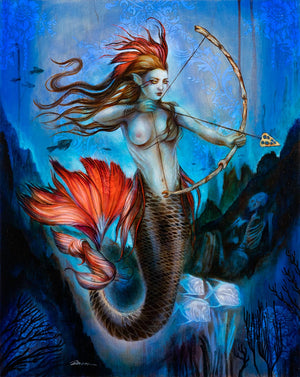Far away from the sterile, pseudo-sanctified realm of the art museum, Tino Rodriguez gained his first exposure to the art world in the Catholic churches of Mexico. In these mysterious, hushed interiors, images of saints and angels seduced him, the scent of candle wax and incense beguiled him. Angels in particular – androgynous, half animal-half human creatures – captivated Rodriguez with their allure. The legacy of this seduction is visible in Rodriguez' work.
His fantastic paintings are present postmodern fairy tales. Their mythical qualities stem from childhood legacies. Rodriguez came of age surrounded by the Mexican tradition of oral story telling. His grandmother, family and friends passed on stories as diverse as La Llorna, Little Riding Hood, and tales of the Brothers Grimm, as well as Aztec & Mayan myths. In his paintings such different cultural influences now commingle with art historical references, Hindu deities and allusions to the contemporary world.
Rodriguez' work also challenges received gender ideologies, another strategy with personal roots. Many of his self-referential images borrow iconographies traditionally associated with femininity in an attempt to claim for himself and others "feminine" behaviors and feelings. Thus, images of babies and fetuses as well as androgynous figures donning bridal veils populate his paintings, insisting that procreation, nurturing, creativity and beauty be the modus operandi open to all. The veils, in particular, are potent signifiers of his
personal history. As a child, Rodriguez dressed up and danced in his sister's first communion veil. Weaving together signifiers from Celtic fables, Northern European fairy tales, Mexican myths, Native American legends, the history of art, as well as Catholic and Hindu iconography, magic, cross pollination, and gender are major themes in the art of Tino Rodriguez. A citizen of the world, Rodriguez rejects the seriousness and sterility of modernism for the fantastic iconographic wonders of postmodernism and post colonialism. In addition, his paintings – reflective but not literal, self-referential but not solely self-destructive – conjure events from his personal history in an attempt to engage the beholder in dialogue.
Charlene Villasenor-Black












